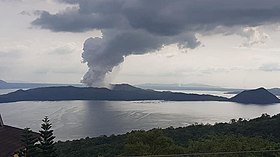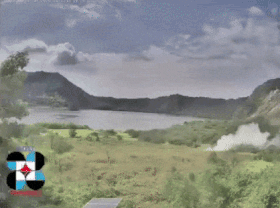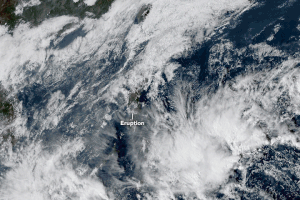The Columbia River Basalt Group (including the Steen and Picture Gorge basalts) extends over portions of five states.
The Columbia River Basalt Group is the youngest, smallest and one of the best-preserved continental flood basalt province on Earth, covering over 210,000 km2 (81,000 sq mi) mainly eastern Oregon and Washington, western Idaho, and part of northern Nevada. The basalt group includes the Steen and Picture Gorge basalt formations.
Introduction
During the middle to late Miocene epoch, the Columbia River flood basalts engulfed about 163,700 km2 (63,200 sq mi) of the Pacific Northwest, forming a large igneous province with an estimated volume of 174,300 km3
(41,800 cu mi). Eruptions were most vigorous 17–14 million years ago,
when over 99 percent of the basalt was released. Less extensive
eruptions continued 14–6 million years ago.
Erosion resulting from the Missoula Floods has extensively exposed these lava flows, laying bare many layers of the basalt flows at Wallula Gap, the lower Palouse River, the Columbia River Gorge and throughout the Channeled Scablands.
The Columbia River Basalt Group is thought to be a potential link to the Chilcotin Group in south-central British Columbia, Canada. The Latah Formation
sediments of Washington and Idaho are interbedded with a number of the
Columbia River Basalt Group flows, and outcrop across the region.
Absolute dates, subject to a statistical uncertainty, are determined through radiometric dating using isotope ratios such as 40Ar/39Ar dating, which can be used to identify the date of solidifying basalt. In the CRBG deposits 40Ar, which is produced by 40K decay, only accumulates after the melt solidifies.
Other flood basalts include the Deccan Traps (late Cretaceous period), that cover an area of 500,000 km2 (200,000 sq mi) in west-central India; the Emeishan Traps (Permian), which cover more than 250,000 square kilometers in southwestern China; and Siberian Traps (late Permian) that cover 2 million km2 (800,000 sq mi) in Russia.
Formation of the Columbia River Basalt Group
Some
time during a 10–15 million-year period, lava flow after lava flow
poured out, eventually reaching a thickness of more than 1.8 km
(5,900 ft). As the molten rock came to the surface, the Earth's crust
gradually sank into the space left by the rising lava. This subsidence
of the crust produced a large, slightly depressed lava plain now known
as the Columbia Basin or Columbia River Plateau. The northwesterly advancing lava forced the ancient Columbia River
into its present course. The lava, as it flowed over the area, first
filled the stream valleys, forming dams that in turn caused impoundments
or lakes. In these ancient lake beds are found fossil leaf impressions, petrified wood, fossil insects, and bones of vertebrate animals.
In the middle Miocene, 17 to 15 Ma, the Columbia Plateau and the
Oregon Basin and Range of the Pacific Northwest were flooded with lava
flows. Both flows are similar in both composition and age, and have been
attributed to a common source, the Yellowstone hotspot. The ultimate cause of the volcanism is still up for debate, but the most widely accepted idea is that the mantle plume
or upwelling (similar to that associated with present-day Hawaii)
initiated the widespread and voluminous basaltic volcanism about
17 million years ago. As hot mantle plume materials rise and reach lower
pressures, the hot materials melt and interact with the materials in
the upper mantle, creating magma. Once that magma breaches the surface, it flows as lava and then solidifies into basalt.
Transition to flood volcanism
In the Palouse River
Canyon just downstream of Palouse Falls, the Sentinel Bluffs flows of
the Grand Ronde Formation can be seen on the bottom, covered by the
Ginkgo Flow of the Wanapum Basalt.
Prior to 17.5 million years ago, the Western Cascade Stratovolcanoes erupted with periodic regularity for over 20 million years, even as they do today. An abrupt transition to shield volcanic
flooding took place in the mid-Miocene. The flows can be divided into
four major categories: The Steens Basalt, Grande Ronde Basalt, the
Wanapum Basalt, and the Saddle Mountains Basalt. The various lava flows
have been dated by radiometric dating—particularly through measurement
of the ratios of isotopes of potassium to argon.
The Columbia River flood basalt province comprises more than 300
individual basalt lava flows that have an average volume of 500 to 600
cubic kilometres (120 to 140 cu mi).
Cause of the volcanism
Major hot-spots have often been tracked back to flood-basalt events. In this case the Yellowstone hotspot's initial flood-basalt event occurred near Steens Mountain when the Imnaha and Steens eruptions began. As the North American Plate moved several centimeters per year westward, the eruptions progressed through the Snake River Plain across Idaho and into Wyoming. Consistent with the hot spot hypothesis, the lava flows are progressively younger as one proceeds east along this path.
There is additional confirmation that Yellowstone is associated with a deep hot spot. Using tomographic images
based on seismic waves, relatively narrow, deeply seated, active
convective plumes have been detected under Yellowstone and several other
hot spots. These plumes are much more focused than the upwelling
observed with large-scale plate-tectonics circulation.
Location of Yellowstone Hotspot in millions of Years Ago
CRB-Yellowstone mantle plume model
The hot spot hypothesis is not universally accepted as it has not
resolved several questions. The Yellowstone hot spot volcanism track
shows a large apparent bow in the hot-spot track that does not
correspond to changes in plate motion if the northern CRBG floods are
considered. Further, the Yellowstone images show necking of the plume
at 650 km (400 mi) and 400 km (250 mi), which may correspond to phase
changes or may reflect still-to-be-understood viscosity effects.
Additional data collection and further modeling will be required to
achieve a consensus on the actual mechanism.
Speed of flood basalt emplacement
Yaquina Head Lighthouse sits atop erosion-resistant Ginkgo flow basalt over 500 km (310 mi) from its origin.
The Columbia River Basalt Group flows exhibit essentially uniform
chemical properties through the bulk of individual flows, suggesting
rapid placement. Ho and Cashman (1997) characterized the 500 km
(310 mi)-long Ginkgo flow of the Columbia River Basalt Group,
determining that it had been formed in roughly a week, based on the
measured melting temperature along the flow from the origin to the most
distant point of the flow, combined with hydraulics considerations. The
Ginkgo basalt was examined over its 500 km (310 mi) flow path from a
Ginkgo flow feeder dike near Kahlotus, Washington to the flow terminus in the Pacific Ocean at Yaquina Head, Oregon.
The basalt had an upper melting temperature of 1095 ± 5 °C and a lower
temperature to 1085 ± 5 °C; this indicates that the maximum temperature
drop along the Ginkgo flow was 20 °C. The lava must have spread quickly
to achieve this uniformity. Analyses indicate that the flow must remain
laminar, as turbulent flow would cool more quickly. This could be
accomplished by sheet flow, which can travel at velocities of 1 to 8
metres per second (2.2 to 17.9 mph) without turbulence and minimal
cooling, suggesting that the Ginkgo flow occurred in less than a week.
The cooling/hydraulics analyses are supported by an independent
indicator; if longer periods were required, external water from
temporarily dammed rivers would intrude, resulting in both more dramatic
cooling rates and increased volumes of pillow lava.
Ho's analysis is consistent with the analysis by Reidel et al. (1994),
who proposed a maximum Pomona flow emplacement duration of several
months based on the time required for rivers to be reestablished in
their canyons following a basalt flow interruption.
Dating of the flood basalt flows
Looking south in Hole in the Ground Coulee,
Washington. The upper basalt is a Priest Rapids Member flow lying above
a Roza Member flow, while the lower canyon exposes a layer of Grand
Ronde basalt.
Three major tools are used to date the CRBG flows: stratigraphy,
radiometric dating, and magnetostratigraphy. These techniques have been
key to correlating data from disparate basalt exposures and boring
samples over five states.
Major eruptive pulses of flood basalt lavas are laid down stratigraphically.
The layers can be distinguished by physical characteristics and
chemical composition. Each distinct layer is typically assigned a name
usually based on area (valley, mountain, or region) where that formation
is exposed and available for study. Stratigraphy provides a relative
ordering (ordinal ranking) of the CRBG layers.
Absolute dates, subject to a statistical uncertainty, are determined through radiometric dating using isotope ratios such as 40Ar/39Ar dating, which can be used to identify the date of solidifying basalt. In the CRBG deposits 40Ar, which is produced by 40K decay, only accumulates after the melt solidifies.
Parts of the Grande Ronde, Wanapum and Saddle Mountains basalts (in order from the bottom) are exposed at the Wallula Gap.
Magnetostratigraphy
is also used to determine age. This technique uses the pattern of
magnetic polarity zones of CRBG layers by comparison to the magnetic
polarity timescale. The samples are analyzed to determine their
characteristic remanent magnetization from the Earth's magnetic field at
the time a stratum was deposited. This is possible as magnetic minerals
precipitate in the melt (crystallize), they orient themselves with
Earth's magnetic field.
The Steens Basalt captured a highly detailed record of the
earth's magnetic reversal that occurred roughly 15 million years ago.
Over a 10,000-year period, more than 130 flows solidified – roughly one
flow every 75 years. As each flow cooled below about 500 °C (932 °F), it
captured the magnetic field's orientation-normal, reversed, or in one
of several intermediate positions. Most of the flows froze with a single
magnetic orientation. However, several of the flows, which freeze from
both the upper and lower surfaces, progressively toward the center,
captured substantial variations in magnetic field direction as they
froze. The observed change in direction was reported as 50⁰ over 15
days.
The major Columbia River Basalt Group flows
Steens Basalt
View from the top of Steens Mountain, looking out to Alvord Desert with basalt layers visible on the eroded face.
The Steens Basalt flows covered about 50,000 km2
(19,000 sq mi) of the Oregon Plateau in sections up to 1 km (3,300 ft)
thick. It contains the earliest identified eruption of the CRBG large
igneous province. The type locality for the Steens basalt, which covers a large portion of the Oregon Plateau, is an approximately 1,000 m (3,300 ft) face of Steens Mountain
showing multiple layers of basalt. The oldest of the flows considered
part of the Columbia River Basalt Group, the Steens basalt, includes
flows geographically separated but roughly concurrent with the Imnaha
flows. Older Imnaha basalt north of Steens Mountain overlies the
chemically distinct lowermost flows of Steens basalt; hence some flows
of the Imnaha are stratigraphically younger than the lowermost Steens
basalt.
One geomagnetic field reversal occurred during the Steens Basalt eruptions at approximately 16.7 Ma, as dated using 40Ar/39Ar ages and the geomagnetic polarity timescale.
Steens Mountain and related sections of Oregon Plateau flood basalts at
Catlow Peak and Poker Jim Ridge 70 to 90 km (43 to 56 mi) to the
southeast and west of Steens Mountain, provide the most detailed
magnetic field reversal data (reversed-to-normal polarity transition)
yet reported in volcanic rocks.
Imnaha Basalt
The second oldest flows, the Imnaha Basalt, are exposed at the type locality: Imnaha, Oregon.
Virtually coeval with oldest of the flows, the Imnaha basalt flows
welled up across northeastern Oregon. There were 26 major flows over the
period, one roughly every 15,000 years. Although estimates are that
this amounts to about 10% of the total flows, they have been buried
under more recent flows, and are visible in few locations. They can be seen along the lower benches of the Imnaha River and Snake River in Wallowa county.
The Imnaha lavas have been dated using the K–Ar technique, and
show a broad range of dates. The oldest is 17.67±0.32 Ma with younger
lava flows ranging to 15.50±0.40 Ma. Although the Imnaha Basalt overlies
Lower Steens Basalt, it has been suggested that it is interfingered
with Upper Steens Basalt.
Grande Ronde Basalt
Saddle Mountains basalt dikes penetrating Grande Ronde basalts.
The next oldest of the flows, from 17 million to 15.6 million years
ago, make up the Grande Ronde Basalt. Units (flow zones) within the
Grande Ronde Basalt include the Meyer Ridge and the Sentinel Bluffs
units. Geologists estimate that the Grande Ronde Basalt comprises about
85 percent of the total flow volume. It is characterized by a number of dikes called the Chief Joseph Dike Swarm near Joseph, Enterprise, Troy and Walla Walla
through which the lava upwelling occurred (estimates range to up to
20,000 such dikes). Many of the dikes were fissures 5 to 10 m (16 to
33 ft) wide and up to 10 miles (16 km) in length, allowing for huge
quantities of magma upwelling. Much of the lava flowed north into
Washington as well as down the Columbia River channel to the Pacific Ocean; the tremendous flows created the Columbia River Plateau. The weight of this flow caused central Washington to sink, creating the broad Columbia Basin in Washington. The type locality for the formation is the canyon of the Grande Ronde River. Grande Ronde basalt flows and dikes can also be seen in the exposed 2,000-foot (610 m) walls of Joseph Canyon along Oregon Route 3.
The type locality for the Grande Ronde Basalt lies along the lower Grande Ronde as shown here.
The Grande Ronde basalt flows flooded down the ancestral Columbia River channel to the west of the Cascade Mountains. It can be found exposed along the Clackamas River and at Silver Falls State Park where the falls plunge over multiple layers of the Grande Ronde basalt. Evidence of eight flows can be found in the Tualatin Mountains on the west side of Portland.
Individual flows included large quantities of basalt. The McCoy Canyon flow of the Sentinel Bluffs Member released 4,278 km3
(1,026 cu mi) of basalt in layers of 10 to 60 m (33 to 197 ft) in
thickness. The Umtanum flow has been estimated at about 2,750 km3 (660 cu mi) in layers 50 m (160 ft) deep. The Pruitt Draw flow of the Teepee Butte Member released about 2,350 km3 (560 cu mi) with layers of basalt up to 100 m (330 ft) thick.
Wanapum Basalt
Three Devil's grade in Moses Coulee, Washington. The upper basalt is Roza Member, while the lower canyon exposes Frenchman Springs Member basalt.
The Wanapum Basalt is made up of the Eckler Mountain Member
(15.6 million years ago), the Frenchman Springs Member (15.5 million
years ago), the Roza Member (14.9 million years ago) and the Priest
Rapids Member (14.5 million years ago). They originated from vents between Pendleton, Oregon and Hanford, Washington.
The Frenchman Springs Member flowed along similar paths as the
Grande Ronde basalts, but can be identified by different chemical
characteristics. It flowed west to the Pacific, and can be found in the
Columbia Gorge, along the upper Clackamas River, the hills south of Oregon City. and as far west as Yaquina Head near Newport, Oregon—a distance of 750 km (470 mi).
Saddle Mountains Basalt
The Saddle Mountains Basalt, seen prominently at the Saddle Mountains,
is made up of the Umatilla Member flows, the Wilbur Creek Member flows,
the Asotin Member flows (13 million years ago), the Weissenfels Ridge
Member flows, the Esquatzel Member flows, the Elephant Mountain Member
flows (10.5 million years ago), the Bujford Member flows, the Ice Harbor
Member flows (8.5 million years ago) and the Lower Monumental Member
flows (6 million years ago).
Related geologic structures
Oregon High Lava Plains
Level
IV ecoregions in the Northern Basin and Range in Oregon, Idaho, Utah,
and Nevada. The light brown region numbered 80g represent the High Lava
Plains
Camp & Ross (2004)
observed that the Oregon High Lava Plains is a complementary system of
propagating rhyolite eruptions, with the same point of origin. The two
phenomena occurred concurrently, with the High Lava Plains propagating
westward since ~10 Ma, while the Snake River Plains propagated eastward.























